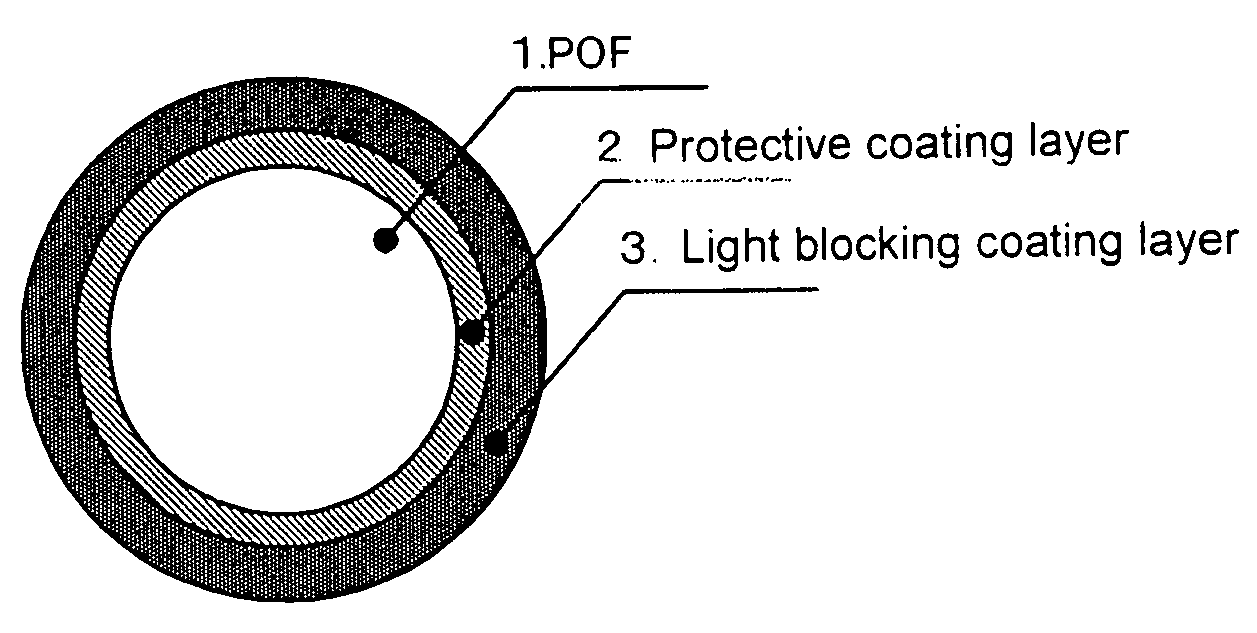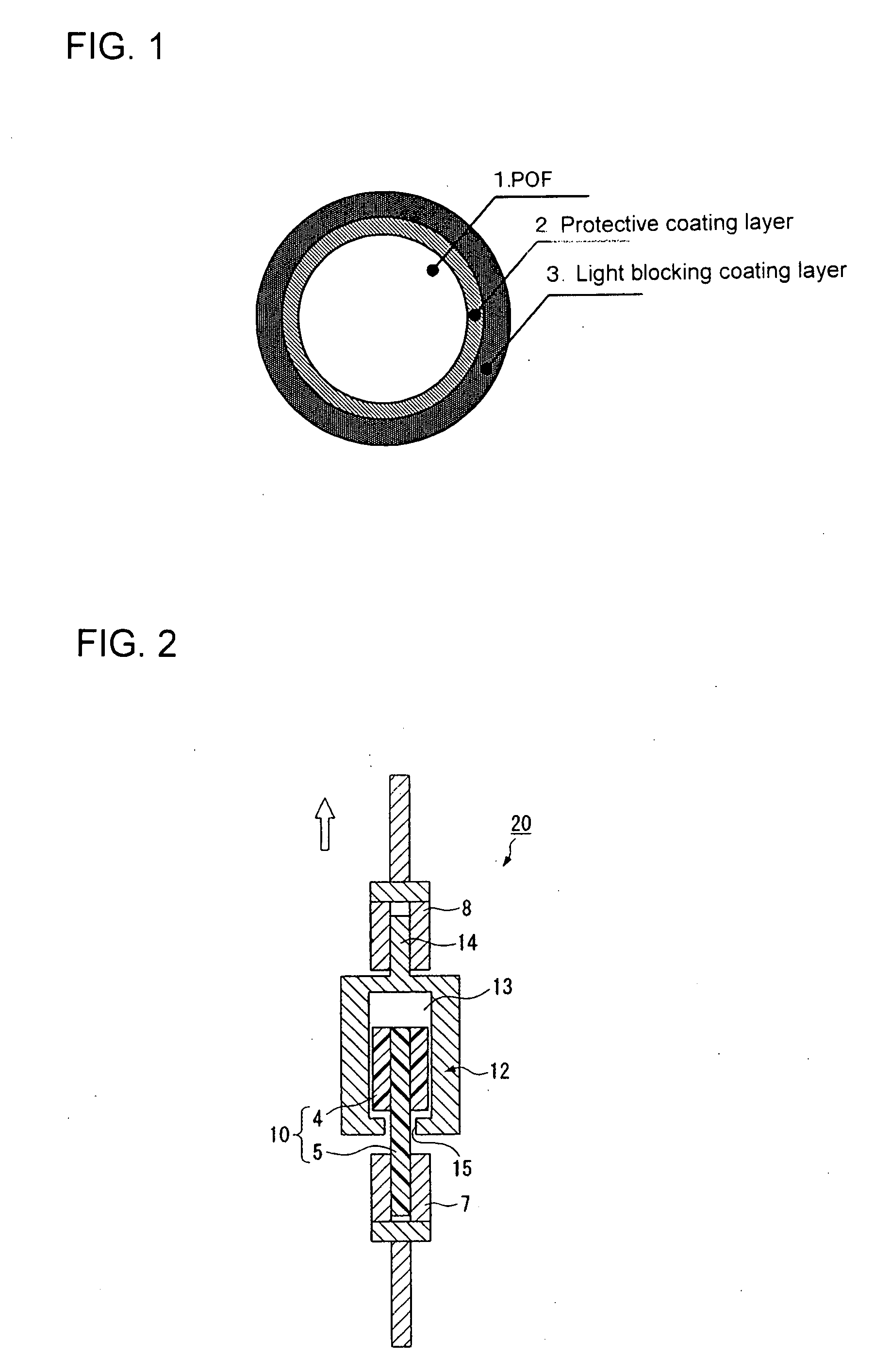Plastic optical fiber cable
a technology of optical fiber and plastic fiber, applied in the direction of optical fiber with multi-layer core/cladding, optical waveguide light guide, instruments, etc., can solve the problems of increasing transmission loss, increasing transmission loss, and high cost of quarter-inch optical fibers, and achieves the effect of long-term heat resistan
- Summary
- Abstract
- Description
- Claims
- Application Information
AI Technical Summary
Benefits of technology
Problems solved by technology
Method used
Image
Examples
example 1
[0126]The cable coating apparatus equipped with a crosshead die set at 210° C. was used to fabricate a POF in a way similar to Comparative Example 1 described above. The outer surface of the POF was coated with a MMA / MAA copolymer (composition ratio: 98 / 2 (% by weight), melt flow index: 60 g / min) as the protective coating material, and the outer surface of the protective coating was coated with a commercially available nylon 12 resin (Daicel-Degussa Ltd., Model Name: Daiamide-L1640) having a terminal amino group content of 2 μeq / g or lower, to which 1% by weight of carbon black was added. The above coating process was performed through co-extrusion. There was thus provided a POF cable having the protective coating layer (thickness: 60 μm) and the light blocking coating layer (thickness: 190 μm), the outer diameter of the POF cable being 1.5 mm. Various evaluations were conducted on the resultant POF cable, and the evaluation results are shown in Table 2.
example 2
[0127]The same materials as those used in Example 1 were used for the core material, the first clad material, the second clad material, and the protective coating layer. These polymers were melted, supplied to the spinning fiber head at 230° C., and underwent a conjugate fiber spinning process by using the concentric conjugate nozzles. Then, in the hot air furnace at 140° C., the resultant fiber was drawn to be twice in length in the fiber axis direction. A 1 mm-diameter POF in which the thickness of each of the first clad, the second clad, and the protective coating layer was 10 μm was thus provided. The resultant POF had a good initial transmission loss of 134 dB / km. The outer surface of the POF was coated with the same light blocking coating layer as that in Example 1 through co-extrusion. A POF cable having an outer diameter of 1.5 mm was thus fabricated. Various evaluations were conducted on the resultant POF cable, and the evaluation results are shown in Table 2.
example 3
[0128]PMMA (refractive index: 1.492) was used for the core material. A copolymer of VdF / TFE / HFP / PFPVE (composition ratio: 21 / 55 / 18 / 6 (% by weight), refractive index: 1.350, crystal melting heat (ΔH): 8 mJ / mg) was used for the clad material. A MMA / MAA / butylacrylate (BA) copolymer (composition ratio: 88 / 2 / 10 (% by weight), melt flow index: 61 g / min) was used for the protective coating layer. A method similar to that used in Example 2 was used to provide a POF having a diameter of 1 mm in which the thickness of each of the clad and the protective coating layer was 10 μm. The resultant POF had a good initial transmission loss of 132 dB / km. The outer surface of the POF was coated with a commercially available nylon 11 resin (Atofina, Model Name: RILSAN BMF-0) as the light blocking coating layer, to which 1% by weight of carbon black was added, in a way similar to Example 2. A POF cable was thus fabricated. Various evaluations were conducted on the resultant POF cable, and the evaluation ...
PUM
| Property | Measurement | Unit |
|---|---|---|
| temperature | aaaaa | aaaaa |
| heat resistance | aaaaa | aaaaa |
| temperature | aaaaa | aaaaa |
Abstract
Description
Claims
Application Information
 Login to View More
Login to View More - R&D
- Intellectual Property
- Life Sciences
- Materials
- Tech Scout
- Unparalleled Data Quality
- Higher Quality Content
- 60% Fewer Hallucinations
Browse by: Latest US Patents, China's latest patents, Technical Efficacy Thesaurus, Application Domain, Technology Topic, Popular Technical Reports.
© 2025 PatSnap. All rights reserved.Legal|Privacy policy|Modern Slavery Act Transparency Statement|Sitemap|About US| Contact US: help@patsnap.com



